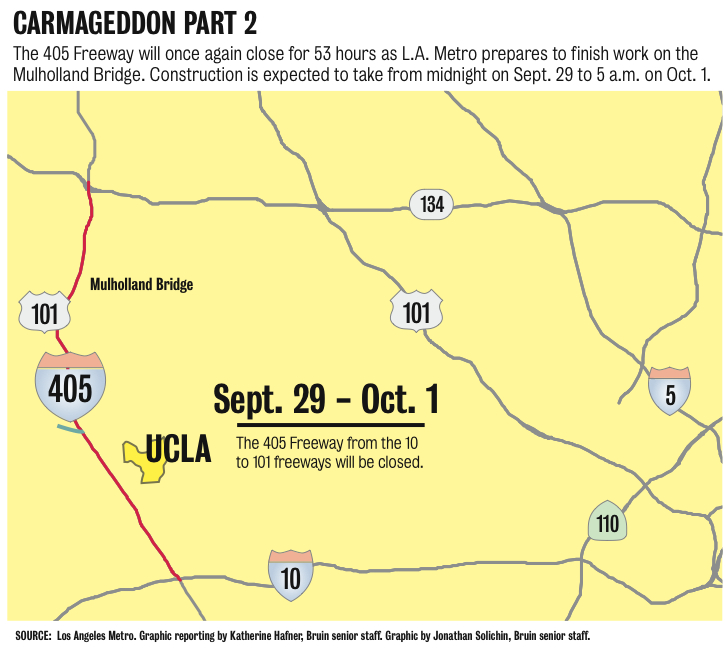Southern California drivers brace for Carmageddon’s return as Metro improves 405 Freeway

By Lawrence Han
Sept. 23, 2012 8:51 a.m.
Southern California motorists must brace for traffic congestion next week as Los Angeles Metro once again prepares to close a section of the 405 Freeway for construction.
Starting at 7 p.m. on Sept. 28, metro officials will close the northbound lanes between the 10 and 101 freeways, and southbound lanes between the 101 Freeway and Getty Center Drive, to finish renovating the Mulholland Bridge, said Dave Sotero, a Metro spokesman. The entire freeway will be off limits by midnight.
The construction project, known as “Carmageddon II,” is estimated to take 53 hours, from midnight Sept. 29 until 5 a.m. Oct. 1, Sotero said.
The first phase of demolition of the bridge in July 2011 produced similar freeway closures. It was dubbed “Carmageddon” because of predictions that traffic in Los Angeles would increase dramatically as a result of the closure.
Both closures, as well as the ongoing construction that began this summer on the Wilshire Boulevard on- and off-ramps, are directed by Metro, and fall under the umbrella of the I-405 Sepulveda Pass Improvement Project.
The project received $1 billion from the city of Los Angeles to accomplish the construction, said David Karwaski, UCLA Transportation planning and policy manager.
The project aims to ease traffic congestion by adding a northbound carpool lane, Karwaski said.
Metro selected the last weekend of the month to avoid as many events that can increase congestion in the area, particularly UCLA move-in weekend, which lasts from Sept. 21 to 23, Karwaski said.
Though roadways neighboring the 405 Freeway were expected to be congested during Carmageddon last July, Sotero said traffic was kept under control because public outreach efforts, such as media speculations warning of exponential increases in traffic, encouraged drivers to stay at home and avoid driving completely.
However, Carmageddon II may prove more troublesome than its predecessor, Sotero said.
“We’re not expecting to be done early this year,” Karwaski said. “But it still shouldn’t take more than the 53 hours.”
While the first Carmageddon finished 17 hours ahead of schedule, it is unlikely that this year’s closure will follow suit, Sotero said.
More construction work is being done compared to last year’s Carmageddon, even though the time estimates for both projects are the same, said Matthew Hissom, senior transportation planner at UCLA.
This year, construction will take place while most schools, including UCLA, are in session, Hissom said.
Traffic tends to increase by about 25 percent when schools are in session, he added.
The UCLA Health System, which could potentially face serious repercussions because of the possible increased congestion, has been preparing for this closure since the first Carmageddon.
“We’ve put in a lot of planning and preparation for that weekend, with experience from last year’s (closure),” said Shannon O’Kelley, chief operating officer for the UCLA Health System.
Preparations will include providing food and room services so employees do not need to leave the area, finding staff who do not use the 405 Freeway to commute to work on that weekend, and communicating with law and traffic enforcement officials for the current states of construction, O’Kelley said.
Metro encourages people to try to stick to local roads during the time frame, or to choose alternative modes of transportation, such as carpooling or public transit.
“We’re trying to encourage the public to see this as an opportunity to have a car-free weekend,” Sotero said.
He added that motorists skeptical about increased congestion because of last year’s Carmageddon success should keep in mind that it was through a collective effort to avoid driving that the first closure went by without issue.
As the project date draws closer, some UCLA students are preparing their weekend travel arrangements beforehand.
“I can always try and catch a ride from a friend if I have to, although I try not to drive too much anyway,” said Yung Park, a third-year linguistics student. “I’ll probably try and stay around Westwood, or bike if I need to get somewhere.”
Jonathan Lee, a third-year business economics student who interns around the Westwood area, feels traffic may pose a problem for those with weekend travel plans.
“I think congestion will be bad, but at least it’s the weekend,” Lee said. “I don’t work on weekends but it’s still going to suck.”
For the students that must drive during the freeway closures, allowing extra travel time is highly recommended, as congestion will be unpredictable, Karwaski said.
Motorists who use the 405 Freeway will likely face continued traffic congestion until the end of 2013, when the construction on the Wilshire Boulevard ramps is expected to finish, Karwaski said.

